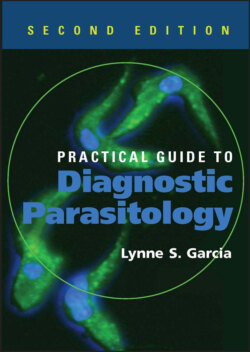Читать книгу Practical Guide to Diagnostic Parasitology - Lynne Shore Garcia - Страница 62
На сайте Литреса книга снята с продажи.
Nematodes (Blood and Tissue)
ОглавлениеBlood and tissue nematodes (filarial worms) are arthropod borne. The adult worms tend to live in the tissues or lymphatics of the vertebrate host. Diagnosis is made on the basis of the recovery and identification of the larval worms (microfilariae) in the blood, other body fluids, or skin. While circulating in peripheral blood or cutaneous tissues, the microfilariae can be ingested by blood-sucking insects. After the larvae mature, they can escape into the vertebrate host’s skin when the arthropod takes its next blood meal. The severity of disease due to these nematodes varies; however, elephantiasis may be associated with some of the filarial worms. Specific organisms include Wuchereria bancrofti, Brugia spp., Loa loa, Mansonella spp., Onchocerca volvulus, and Dirofilaria spp.
